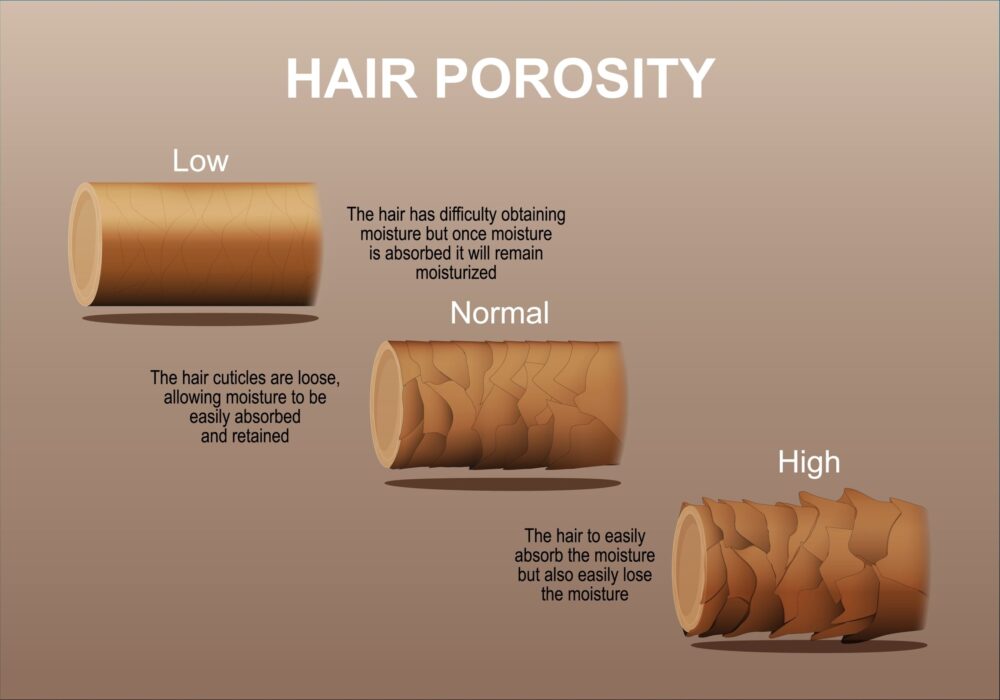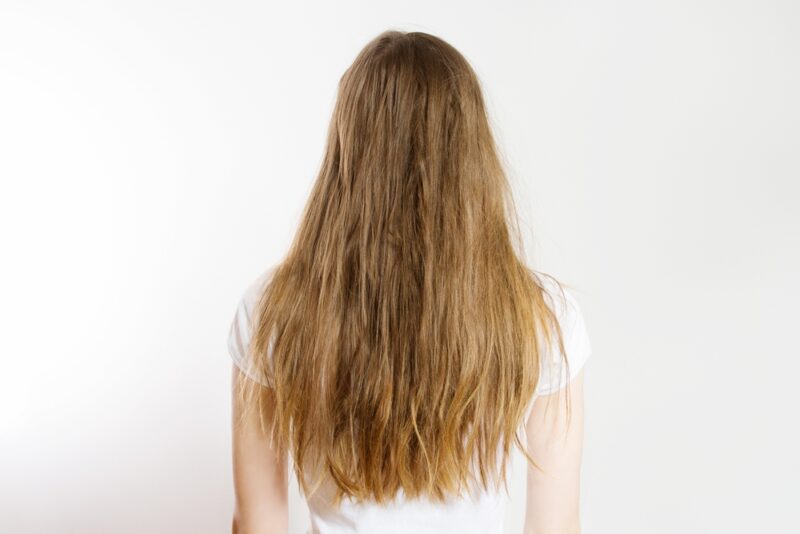Did you know that a single strand of hair can absorb up to 30% of its weight in water? That’s hair porosity in action, the hair’s innate ability to absorb and retain moisture. Hair porosity is largely determined by the structure of the cuticle, the hair’s outermost layer, and is divided into 3 main categories:
- Low Porosity: Tightly bound cuticles resist moisture.
- Medium Porosity: Balanced absorption and retention.
- High Porosity: Open cuticles readily absorb and lose moisture.
Why does this matter? Identifying your hair type and porosity level is the secret to unlocking its healthiest potential.
What Determines Hair Porosity?
Hair porosity is primarily determined by your genetics: you’re often born with a certain porosity level. However, it can also be affected by external factors and treatments over time. Heat styling, chemical processes like coloring and perming, and even environmental factors can damage the hair cuticle, potentially increasing its porosity.
Low Hair Porosity Features
If your hair has low porosity, the cuticles (the outer layer of the hair shaft) are tightly packed together. This makes it a bit of a challenge for moisture to penetrate. You might notice that products tend to sit on top of your hair rather than being absorbed quickly. It can also take longer for your hair to get fully wet in the shower and longer to air dry. While it might be tricky to get moisture in, once it’s there, your hair is pretty good at holding onto it.
- You can find more detailed information here: Ultimate Guide to Low Porosity Hair
Medium Hair Porosity Features
Consider medium porosity the sweet spot! Hair with this porosity has a cuticle layer that’s not too tight and not too open. This means moisture can get in fairly easily and is also retained well. Hair with medium porosity tends to be pretty balanced and often responds well to a variety of hair care products and techniques. It’s generally easier to manage and style.
High Hair Porosity Features
High porosity hair has a more open cuticle layer with gaps and spaces. This allows moisture to be absorbed quickly, which can be a good thing! However, the downside is that this open structure also means that moisture can escape just as easily. Hair like this tends to feel dry and can be prone to frizz and breakage. It often benefits from products that help to seal the cuticle and lock in moisture.
- You can find more detailed information here: Ultimate Guide to High Porosity Hair
What Does Hair Porosity Mean for My Hair?
Your hair porosity dictates how your hair responds to different products and treatments. For instance, low porosity hair has a tighter outer layer, making it harder for moisture to get in, but once it does, it’s likely to stay put.
High porosity hair, on the other hand, has a more open structure, readily absorbing moisture but also losing it quickly. Understanding this helps you choose the right products and techniques to keep your locks healthy and happy.
Hair Porosity Test: Identify Your Type & Level
Where does your hair fall on the porosity spectrum? Here’s a simple test you can try to answer that question:
- Take a few clean strands of your dry hair (make sure they’re product-free).
- Place them in a glass of room temperature water.
- Observe what happens after a few minutes:
- Low Porosity: The hair strands will likely float on the surface of the water.
- Medium Porosity: The strands will probably hover somewhere in the middle of the glass.
- High Porosity: The strands will likely sink to the bottom of the glass.
Keep in mind that this is just a basic test and might not be 100% accurate, but it can give you a good starting point!
Low Porosity vs. High Hair Porosity
The main difference boils down to the structure of the hair’s outer layer, the cuticle. Low porosity hair has a tightly bound cuticle that resists moisture absorption but retains it well once it gets in. High porosity hair has a more open cuticle that absorbs moisture quickly but also loses it just as fast. This difference dictates how you should care for your hair to keep it healthy and hydrated.
How Does Low Hair Porosity Look Like
Low porosity hair often looks smooth and can be quite shiny because the tightly packed cuticle reflects light well. However, it might also feel dry or product can build up easily on the surface, making it feel heavy or weighed down. It can take a while for it to fully absorb conditioners or treatments, and it might take longer to dry after washing.
How Does High Hair Porosity Look Like
High porosity hair can sometimes look dull or lack shine because the open cuticle doesn’t reflect light as effectively. It tends to absorb water and products quickly, but it can also feel dry and brittle easily. You might notice more frizz, and your hair might tangle easily. It also tends to air dry relatively quickly because it loses moisture so readily.
How to Take Care of Low Hair Porosity
The key with low porosity hair is to help moisture penetrate the tightly packed cuticle. Here are a few tips:
- Use heat: Applying mild heat (like with a steamer or a warm towel) can help to lift the cuticle and allow products to be absorbed more effectively.
- Lightweight products: Opt for lightweight, water-based products that won’t sit on the surface and cause buildup. Think serums, liquid conditioners, and light oils.
- Apply products to damp hair: This can help with absorption.
- Clarify regularly: To prevent product buildup, use a clarifying shampoo occasionally.
How to Take Care of High Hair Porosity
For high porosity hair, the focus is on sealing the cuticle to prevent moisture loss after it’s absorbed. Here’s what you can do:
- Use leave-in conditioners and sealants: After moisturizing, use a leave-in conditioner and then follow with a sealant like a heavier oil (e.g., castor oil, shea butter) to help trap the moisture in.
- Protein treatments: These can help to fill in the gaps in the hair cuticle, making it less porous and stronger.
- Rinse with cool water: This can help to close the cuticle after conditioning.
- Gentle handling: High porosity hair is often more fragile, so handle it gently to avoid breakage.
Curious About Hair Porosity? Get a Free Consultation
Do you have other hair concerns? Dr. Serkan Aygin, a globally recognized dermatologist with decades of experience in hair health, and his expert trichologist team offer complimentary online consultations.
Get tailored recommendations and start your journey to healthier, more vibrant hair today.
FAQs
Is low or high porosity hair better?
Neither low nor high porosity hair is inherently “better” – they simply have different characteristics and require different care. The goal is to understand your hair’s porosity and tailor your routine to meet its specific needs. Healthy, well-cared-for hair of any porosity can look and feel amazing!
What does low porosity hair feel like?
Low porosity hair can often feel smooth to the touch, but it might also feel dry or as though products are just sitting on top of it. It might not readily absorb moisture when you wet it, and it can take a while to fully saturate.
What are the symptoms of high porosity hair?
Symptoms of high porosity hair include hair that feels dry and brittle, tangles easily, absorbs products quickly but also loses moisture rapidly, and tends to be prone to frizz. It also usually air dries very quickly.
How often should I wash low porosity hair?
How often you wash low porosity hair depends on your scalp and lifestyle, but generally, you might not need to wash it as frequently as high porosity hair. Product buildup can be a concern, so pay attention to how your hair feels. If it starts to feel heavy or coated, it’s likely time for a wash. Aim for washing every few days to once a week, adjusting as needed.




